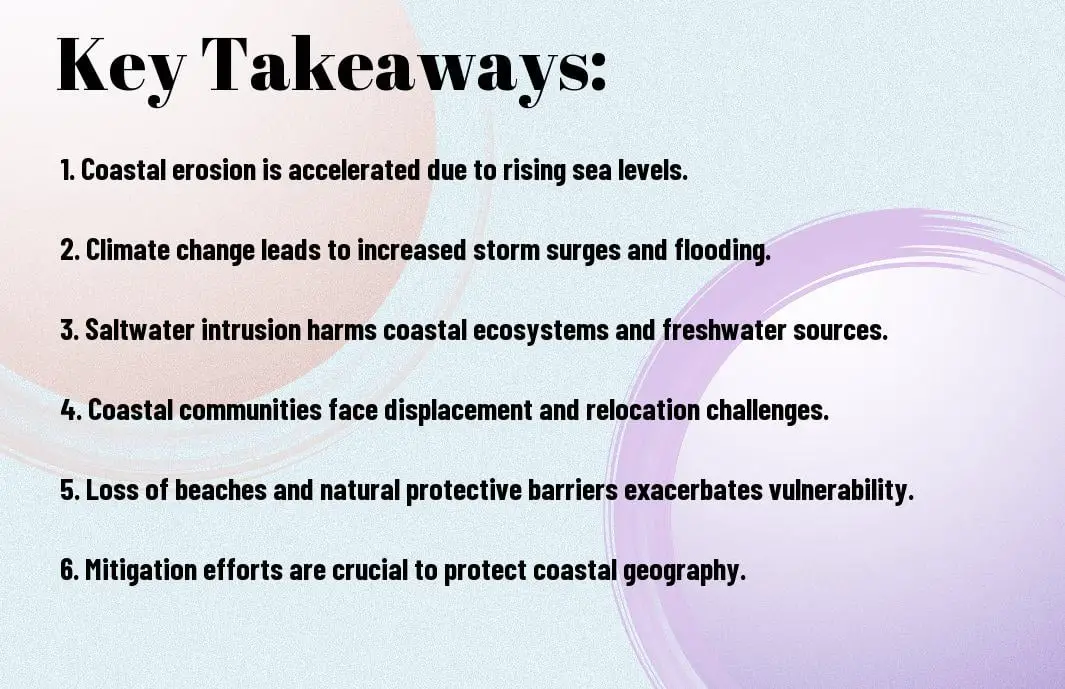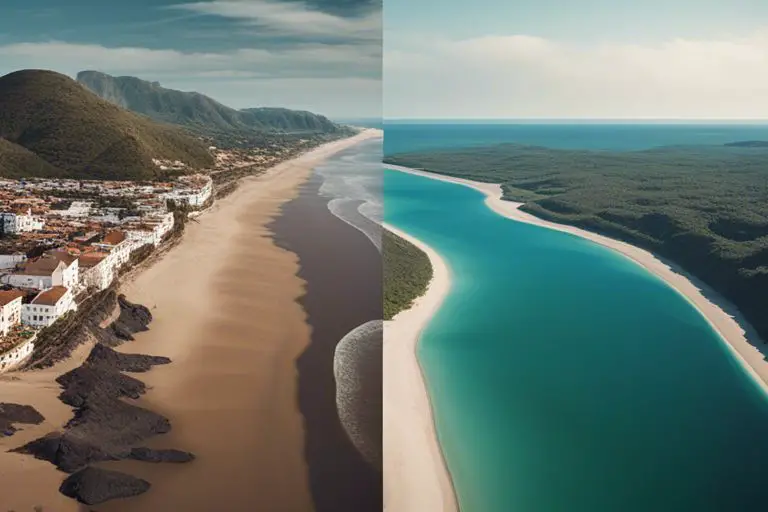Greetings, esteemed readers. As we delve into the complexities of our changing climate, it is crucial to examine the profound effects it has on our coastal geography. The rapid rise in global temperatures has led to unprecedented changes in sea levels, storm patterns, and erosion rates, posing significant challenges to coastal communities around the world. In this informative blog post, we will take a closer look at the dangerous implications of climate change on coastal geography, as well as explore potential solutions and adaptations to mitigate its impact. Join us as we unravel the intricate relationship between climate change and the dynamics of our coastal landscapes.
Key Takeaways:
- Rising Sea Levels: Climate change has resulted in the melting of polar ice caps and thermal expansion of seawater, leading to a rise in sea levels. This has significant consequences for coastal geography, including erosion, inundation, and saltwater intrusion.
- Coastal Erosion and Loss of Land: The intensification of storms and hurricanes due to climate change has contributed to profound coastal erosion, resulting in the loss of land and damage to infrastructure. This has a significant impact on human populations and coastal ecosystems.
- Adaptation and Mitigation Strategies: To address the impact of climate change on coastal geography, adaptation and mitigation strategies such as beach nourishment, shoreline armoring, and managed retreat are being implemented. However, these strategies have trade-offs and must be carefully evaluated for their long-term effectiveness.

Historical Perspective on Coastal Changes
Now, let’s take a closer look at the historical perspective on coastal changes. The shifting of coastlines and the impact of climate change has been a long-standing phenomenon, dating back to the early days of human civilization. Understanding the historical changes in coastlines can provide valuable insights into the current and future impacts of climate change on these vulnerable regions.
Pre-Industrial Revolution Coastlines
Coastal landscapes have been in a state of flux for centuries, influenced by natural processes such as erosion, sedimentation, and sea-level fluctuations. The pre-industrial revolution coastlines were shaped by these natural forces, with gradual changes occurring over long periods of time. Human settlements and civilizations adapted to these changes, often moving inland as coastlines shifted. This historical perspective highlights the dynamic nature of coastal geography and the resilience of human societies in the face of natural coastal changes.
Post-Industrial Revolution: Recognizing Anthropogenic Effects
Perspective Now, the post-industrial revolution period has brought about a new set of challenges for coastal geography. The widespread use of fossil fuels, industrialization, and land-use changes have significantly accelerated coastal changes, leading to erosion, loss of coastal wetlands, and increased vulnerability to extreme weather events. The recognition of anthropogenic effects on coastal landscapes has brought about a new sense of urgency in addressing the impacts of human activities on these dynamic environments. This shift in perspective underscores the need for proactive measures to mitigate the effects of climate change on coastal regions and protect vulnerable coastal communities.
To address these challenges, it is essential to implement sustainable coastal management practices and adaptation strategies that take into account the complex interactions between natural processes and human activities. By integrating scientific research, community engagement, and policy development, coastal regions can build resilience and adapt to the changing climate, protecting lives, livelihoods, and valuable ecosystems. Awareness of the anthropogenic effects on coastlines is a crucial step in developing effective solutions to mitigate the impacts of climate change on coastal geography.
Current Impacts of Climate Change on Coastal Areas
Unlike other regions, coastal areas are particularly vulnerable to the impacts of climate change. The combination of rising sea levels, increasing temperatures, and extreme weather events has led to a range of significant challenges for coastal regions. According to a study on long-term impacts of climate change on coastal and marine ecosystems, the effects of climate change on coastal areas are becoming increasingly apparent and concerning.
Sea-Level Rise and Coastal Erosion
On the forefront of coastal geography impacts is the sea-level rise and coastal erosion. Rising sea levels are leading to the loss of coastal land, increased flooding, and the destruction of important infrastructure. Coastal erosion is accelerating, threatening homes, businesses, and entire communities. The combination of these two factors is creating widespread instability along coastlines, putting human lives and livelihoods at risk. In some cases, entire islands and coastal regions are at risk of disappearing entirely due to these phenomena.
Coastal ecosystems and biodiversity are also facing significant changes as a result of climate change. The warming of ocean waters, in combination with acidification and pollution, is leading to the degradation of habitats and the loss of key species. This has a cascading effect on the entire coastal food web, impacting the livelihoods of those who depend on coastal resources for sustenance and income. The destruction of important coastal ecosystems such as mangroves, salt marshes, and coral reefs further exacerbates the challenges faced by coastal communities.
Coastal ecosystems play a crucial role in mitigating the impacts of climate change, providing protection from storms, absorbing carbon dioxide, and supporting diverse marine life. The loss of these ecosystems not only has dire consequences for the environment and biodiversity, but also for the millions of people who rely on coastal resources for their way of life. It is imperative that we take immediate action to address these coastal challenges and work towards sustainable solutions to protect our coastal regions and the invaluable ecosystems they support.
Adaptation and Mitigation Strategies
Your coastal geography is at risk due to the impact of climate change, but there are adaptation and mitigation strategies that can help protect and sustain your coastal areas. It is essential to implement these strategies to ensure the resilience of your coastal communities and ecosystems.
Engineering Solutions for Coastal Protection
Coastal engineering solutions play a crucial role in protecting coastal areas from the adverse effects of climate change. These solutions include the construction of seawalls, breakwaters, and dikes to mitigate coastal erosion and flooding. Additionally, beach nourishment and restoration projects help to maintain the natural buffer between the ocean and coastal infrastructure, reducing the risk of damage from storm surges and sea-level rise. It is imperative to invest in these engineering solutions to preserve the coastal geography and ensure the safety of coastal communities.
Policy Measures and Sustainable Coastal Management
Policy measures and sustainable coastal management are paramount in addressing the challenges posed by climate change. Strategic land-use planning, coastal zoning regulations, and building codes are essential for minimizing the risks associated with coastal hazards. Integrated coastal management approaches, which involve collaboration among government agencies, local communities, and stakeholders, are vital for the sustainable development of coastal areas.
For instance, implementing coastal setback requirements and encouraging natural dune restoration can help mitigate the impacts of coastal erosion and storm damage. These policy measures and management strategies are crucial for the resilience and sustainability of your coastal geography.
Future Projections and Considerations
Despite the ongoing debate surrounding the extent and impact of climate change, scientists have been able to make some projections regarding the future of coastal geography. These projections are crucial for policymakers and communities to understand the potential challenges and plan for the necessary adaptations.
Predicting Changes in Coastal Geography
Any projections about the future of coastal geography must take into account the potential rise in sea levels, increased frequency of extreme weather events, and the erosion of coastal land. These factors will undoubtedly lead to significant changes in the physical features of coastal areas, including loss of land, changes in sediment deposition, and possible alterations to shoreline configurations. It is important to note that many of these changes are already underway, and their impacts will only intensify in the coming decades.
In addition to these physical changes, there is also the consideration of how human activities and developments will intersect with changing coastal geography. Urbanization, industrialization, and infrastructure development in coastal areas may exacerbate the impacts of climate change, leading to increased vulnerability of communities and ecosystems.
Preparing for Socioeconomic and Environmental Challenges
Predicting the future impacts of climate change on coastal geography requires a comprehensive understanding of the potential socioeconomic and environmental challenges that may arise. There is a need to anticipate disruptions to key economic activities, such as fisheries, tourism, and shipping, which are heavily reliant on coastal resources and infrastructure. Furthermore, there is a critical need to consider the potential displacement of communities, loss of cultural heritage sites, and the impacts on biodiversity and ecosystems.
Considerations of equity, environmental justice, and sustainable development must also be central to any planning and adaptation efforts, ensuring that vulnerable populations and ecosystems are prioritized in the face of these environmental challenges. It is imperative that proactive measures are taken to build resilience, reduce risks, and preserve the ecological and social fabric of coastal areas.
Conclusion: The Impact Of Climate Change On Coastal Geography – A Closer Look
From above, it is evident that climate change is exerting significant pressure on coastal geography, posing a range of challenges and threats to these environments. Rising sea levels, increased frequency and intensity of storms, and coastal erosion are just a few of the consequences of climate change that are impacting coastal regions worldwide. It is crucial for governments and communities to take immediate action to mitigate these effects, through measures such as coastal restoration, sustainable land use, and the implementation of resilient infrastructure. Furthermore, continued research and monitoring are essential to better understand and adapt to the changing coastal landscapes in the face of climate change. By prioritizing the protection and preservation of our coastal geography, we can work towards building more sustainable and resilient communities for future generations.
FAQ
Q: What is the impact of climate change on coastal geography?
A: The impact of climate change on coastal geography is significant and wide-ranging. Rising sea levels, increased coastal erosion, and changing patterns of precipitation all contribute to the transformation of coastal landscapes. These alterations pose a threat to coastal communities and ecosystems, requiring careful monitoring and management.
Q: How does climate change contribute to rising sea levels?
A: Climate change contributes to rising sea levels through the melting of polar ice caps and glaciers, as well as the thermal expansion of ocean water. As global temperatures continue to rise, these processes accelerate, leading to the inundation of coastal areas and low-lying islands. The resulting coastal inundation can have devastating effects on human populations, infrastructure, and biodiversity.
Q: What measures can be taken to mitigate the impact of climate change on coastal geography?
A: Mitigating the impact of climate change on coastal geography requires a multi-faceted approach. This includes implementing coastal protection measures such as seawalls and dikes, as well as investing in sustainable coastal land use planning. Additionally, efforts to reduce greenhouse gas emissions and mitigate the effects of global warming are essential for long-term coastal preservation.


